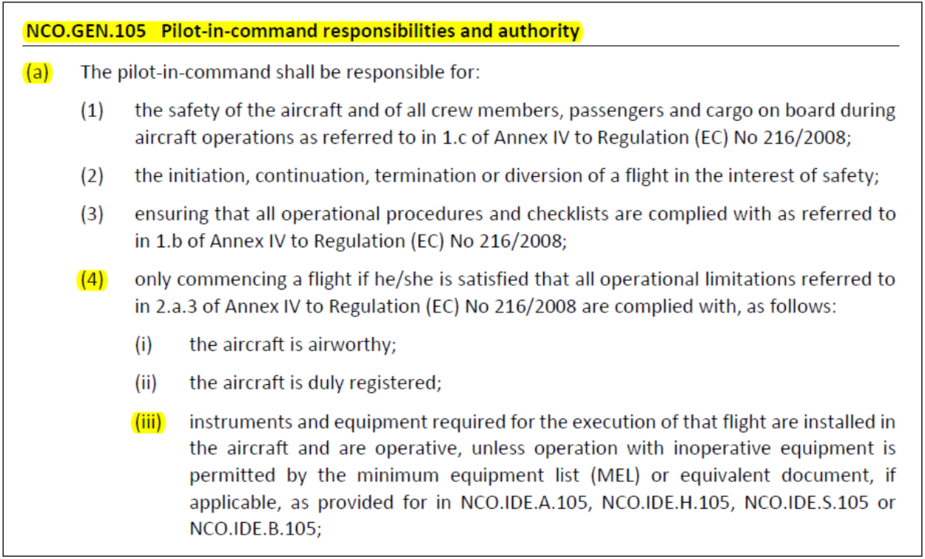gallois wrote:
So if you have a nicely IFR equipped RV6 my question was straightforward. If Dan was to file a I FPL from eg his base to Portugal,would it validate?
I have no doubt he could do it practically and fly an LPV or ILS approach at the other end.
The question is “is it legal”? and what would happen if the NAAs of any of the countries found out that that had been done?
He could file it and it would validate, but the flight technically would be illegal – if he was to be checked on the ground, he would fail the check. If he was to fly from his base to, say Sweden/Norway, then it is a different story – if he was checked there, it might be different as an IFR in non-certified airfracft is permitted there, but the flight (enroute section) is still illegal.
As posted before, enforcement in this area is zero and probably for the reasons posted (ambiguity and nobody wants to test it in court).
My concern would be insurance. But there are data points where insurance did pay out. Where insurance didn’t pay out, the insured isn’t going to be advertising his predicament openly 
Note however there are two level of potential lack of legality:
The 1st is pretty much avoided by flying without Mode S or ADS-B OUT (probably why this chap had a Mode C in a PA46) and nobody will be checking the type on a flight plan.
The 2nd is hard to avoid if you filed an IFR flight plan… this was discussed a few times as one example.
But frankly this is an area which nobody wants to discuss, for obvious reasons. It is however a big reason why I am not flying a 200kt Lancair 
Good answers by @arj1 
Quite a few things have changed in recent years, the more so for the so called Non Commercial other than Complex Aircraft Operations, now contained in the EASA Part-NCO.
The PIC now has full responsibility:

Regarding IFR the NCO.IDE. states:

Would the IFR equipped, non IFR approved in its country, RV with the ICAO designator RV6 file an IFR FPL, it would validate. As mentioned before, the FPL would also validate if either the PIC, or the aircraft itself would not fulfil the requirements for the type of flight intended, VFR, night, or IFR. The PIC has the legal responsibility, and neither ATC nor Eurocontrol can, nor will, reject a FPL based on any of these “invisible” requirements.
But you do have to remain OCAS and/or class E to fly without transponder. Certainly under French air rules. There are certain derogations at certain times of course. Eg Flying an Avion de Collection into an airfield inside CAS for an open day where this derogation has been agreed beforehand. Or as happened to us at LFBH transponder failures inside their Class D.
IFR needs mode S.
Dan wrote:
The PIC has the legal responsibility, and neither ATC nor Eurocontrol can, nor will, reject a FPL based on any of these “invisible” requirements.
I think that unless there is a need to fly in Class A, the pilots of IFR-equipped a/c just fly VFR in IMC, and that is it. While for IFR flight you might be ramp-checked (or, god forbid, if there was incident, the investigators will confirm the flight was not legal), for flying VFR in IMC no one could confirm if you are/were flying in IMC – unless you had video going at the time. :)
Of course, flying under IFR FP is much easier in some countries and more straightforward (for example, UK around London – nightmare under VFR!), in many other countries (France/Germany?) it is not that much different.
That is very true especially when most of us on here fly VMC on top even when under IFR.
I think that unless there is a need to fly in Class A, the pilots of IFR-equipped a/c just fly VFR in IMC, and that is it.
Amazing. Try that in the US and you’d fly a matter of minutes in Class E before catching unwanted attention from ATC, who would be controlling nearby planes under IFR. Unless the plane isn’t transponder or ADS-B equipped (which is admittedly entirely legal in most Class E) it would be essentially impossible, but OTOH it isn’t necessary: if the plane is equipped for IFR and the weather is IMC, it’s flown IFR or not flown.
Silvaire wrote:
you’d fly a matter of minutes in Class E before catching unwanted attention from ATC,
how do they know what’s the actual weather where you are? According to European regulations , VMC on top is VFR , not IFR flight..
According to European regulations , VMC on top is VFR , not IFR flight..
Don’t confuse weather conditions (IMC/VMC) with type of flight (IFR/VFR) – those are two different things.
Emir wrote:
Don’t confuse weather conditions (IMC/VMC) with type of flight (IFR/VFR) – those are two different things.
no, I’m not- I just took the original sentence " the pilots of IFR-equipped a/c just fly VFR in IMC, and that is it." and can’t understand what unwanted attention they might catch in US class E.. I mean it is usally quite difficult for the controller to know whether I’m actually flying VFR in IMC (illegal) or VFR on top of clouds or between clouds in VMC (legal).